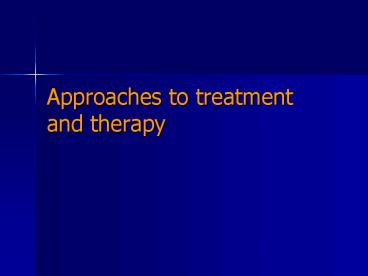Approaches to treatment and therapy - PowerPoint PPT Presentation
Title:
Approaches to treatment and therapy
Description:
Title: Therapies Author: delman Last modified by: Owner Created Date: 5/22/2006 12:48:12 AM Document presentation format: On-screen Show (4:3) Other titles – PowerPoint PPT presentation
Number of Views:90
Avg rating:3.0/5.0
Title: Approaches to treatment and therapy
1
Approaches to treatment and therapy
2
Biological Treatments
3
Biological treatment p406
- Attempting to reduce or eliminate the symptoms of
psychological disorders by altering the way an
individuals body functions. - Psychopharmacology The study of the effects of
drugs on mind and behavior
4
Drug therapy(medication)pp406-407
- The most common form of biological treatment.
- 4 Main Classes of Drugs
Antipsychotic drugs Diminish agitated behavior,
reduce tension, decrease hallucinations and
delusions, and help regulate sleep Antianxiety
drugs (tranquilizers) Reduce anxiety by making
individuals less excitable and more calm
Antidepressent drugs Regulate mood Lithium
carbonate Used to treat bipolar disorder
5
Psychosurgery p410
- Surgery that removes or destroys brain tissue in
an effort to change behavior - Lobotomy A now-rare psychosurgical procedure
once used to calm uncontrollably emotional or
violent patients
6
Electroconvulsive therapy (ECT) pp410-411
- A biomedical therapy for severely depressed
patients in which a brief electric current is
sent through the brain of an anesthetized patient
7
The Psychological Therapies
8
Psychotherapy p412
- An emotionally charged, confiding interaction
between a trained therapist and someone who
suffers from psychological difficulties
9
Psychodynamic therapies p412
- the unconscious mind
- early childhood experiences
- therapist interpretation
10
Psychoanalysis p412
- Psychoanalysis A method of psychotherapy
developed by Freud emphasizing the exploration of
unconscious motives and conflicts - Free association In psychoanalysis, a method of
uncovering unconscious conflicts by saying freely
whatever comes to mind - Dream analysis The technique used by
psychoanalysts to interpret a persons dreams
11
Interpretation
- In psychoanalysis, the analysts noting supposed
dream meanings, resistances, and other
significant behaviors in order to promote insight - Transference The patients transfer to the
analyst of emotions linked with other
relationships (such as love or hatred for a
parent) p412
12
Behavior therapy p413
- Therapy that applies learning principles to the
elimination of unwanted behavior
13
Systematic desensitization p413
- A type of counterconditioning that associates a
pleasant relaxed state with gradually increasing
anxiety-triggering stimuli - ?
14
Aversive conditioning
- A type of counterconditioning that associates an
unpleasant state (such as nausea) with an
unwanted behavior (such as drinking alcohol) - ?
15
Cognitive therapy p415
- Therapy that teaches people new, more adaptive
ways of thinking and acting by
- Examining the evidence for beliefs.
- Considering other explanations for the behavior
of other people. - Identifying assumptions and biases.
16
Humanist therapies p416
- Encourage people to understand themselves and to
grow personally - Client-centered therapy, developed by Carl
Rogers, uses techniques such as active listening
within a genuine, accepting environment to
facilitate clients growth - Unconditional positive regard improves
self-esteem. - The therapists role must be non-directive.
17
Therapy Formats pp417-418
- Conducted by a licensed therapist
- Individual therapy
- Group therapy
- Family therapy
- Couple therapy
- Conducted by group members
- Self-help support groups
18
Eclectic approach
- An approach to psychotherapy that, depending on
the clients problems, uses techniques from
various forms of therapy
19
Successful therapy depends on therapeutic
alliancep419
chapter 12
20
Guidelines for Seeking Help
- Identify the professionals credentials
- When starting therapy, give it some time before
judging its usefulness - Be a thoughtful and careful consumer of mental
health services.































